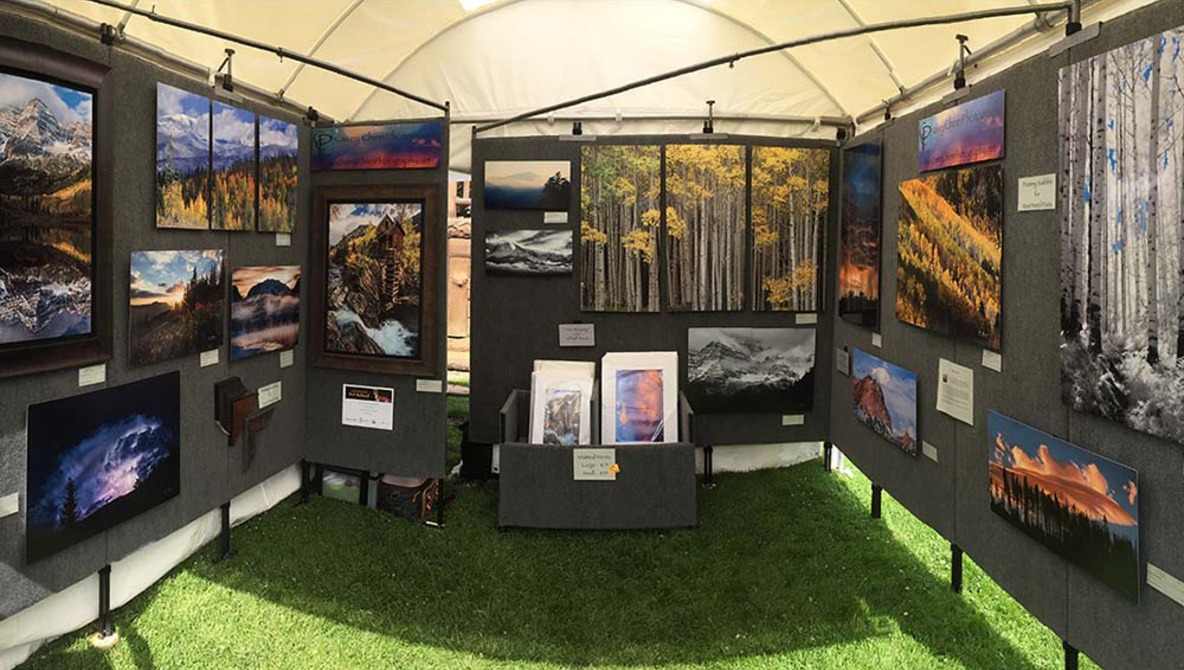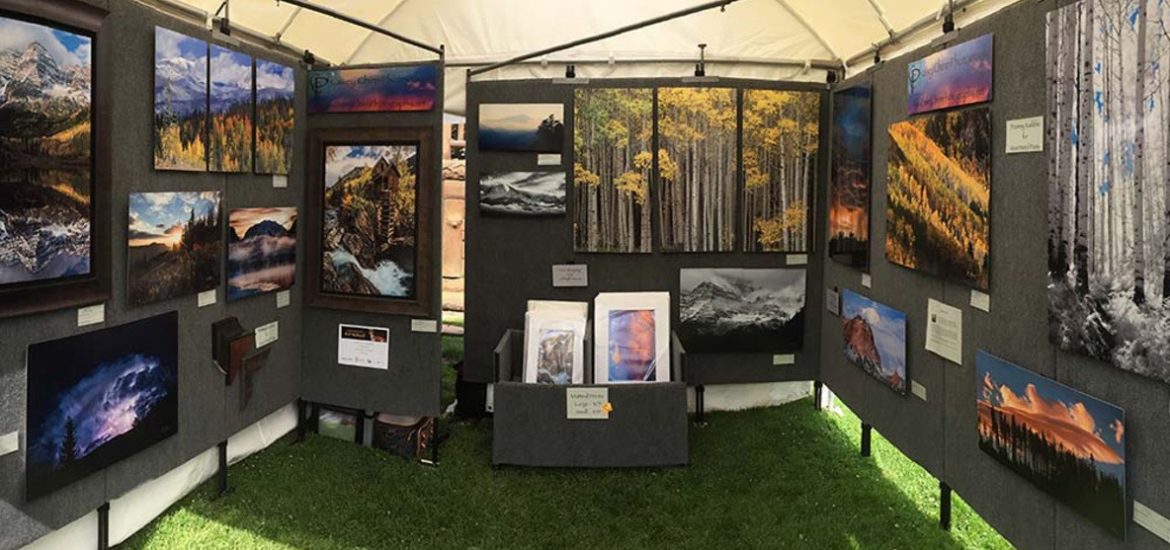
After a decade of selling my work at art festivals, I’ve discovered that beyond the money that I’ve earned, I’ve also gotten some valuable lessons both for my career and for my life.
This article is mainly intended for anyone interested in pursuing showing their work at festivals. I hope my experiences and insights will prove useful.
Realize That It’s a Business
I remember being in an art festival in Aspen, Colorado a few years ago. As I was setting up my booth and getting ready for the weekend, a man walked up to me and started asking some questions, things like how much money I expected to make and how long the festival went on. I later wished I had spent time answering more fully because I had the distinct feeling that the source of his questions was the illusion that artists at art festivals are there to make a killing and this was easy money. Of course, nothing could be further from the truth. And while I’ve had some pretty lucrative art festivals, I’ve also had my share of duds, which this particular festival, unfortunately, proved to be. But being amid setting up my festival booth in the hot July sun, I didn’t bother to fill him in on the reality — that at the end of the day, or the weekend, this endeavor is a whole lot more than just putting a tent up in a park and seeing what happens.
For instance, I might have started by letting him know that before I made any profits, there were, of course, some expenses to be paid. First among these is the booth fee for renting that 10-by-10 patch of turf in the park, which, in this case, was $500.
Additionally, this was an out-of-town show for me in a more affluent part of the state, so my food and lodging costs were quite a bit higher than usual. Then, there were the costs of gas and maintenance for my SUV I use to haul my utility trailer full of prints and a display booth over a mountain pass to this location.
With all of this added up, I couldn’t count on even starting to be in the black until after the first $1,000 had been made. And not a dime of that $1,000 is guaranteed. In fact, at this particular festival, I did poorly and did not make back all my money, so the whole experience ended up being a somewhat expensive hardworking vacation in one of the nicer areas of the state.
Oh, yeah, and that display booth and walls I was setting up? Over $2,000 invested in all of that.
Doing art festivals has helped me realize that selling my art in any meaningful way is a business. Before doing my first one, I created my business as an LLC, got insurance, and then started paying sales taxes. Before that point, I had just been somebody messing around with it and occasionally selling some work at a coffee shop or small gallery show, but now, I was an LLC.
Get To Know Who Your Customer Is
This one has been very valuable for my business. Standing at my booth at an art festival for two or three days solid and chatting with people has been a great way to find out which images resonate the most and why. Getting this first-hand experience has helped me narrow down what to offer, and it’s helped me hone my marketing efforts because I know a little bit about who my best customers tend to be, such as what age group they are in, what some other interests may be, where they live, etc. You can never know with certainty who’s going to buy your work and who is not, but it’s great to have a starting point.
Build an Email List
This is another upside on the business marketing end of things. Over time, I’ve built up a list of people who enjoy my work and enjoy seeing new images and hearing about travels that I’ve taken or what festivals I may be coming to next. Having a good email list is the backbone of any art business, and doing festivals is something that helped to get it off the ground for me.
Another benefit to building an email list is sometimes, if the print sales just aren’t there, I can at least walk away knowing that I’ve added several people to my email list and my fan base. That is one of those things that can pay dividends in the future.
Not All Shows Are Created Equal
Like I said before, this particular festival was a dud for me, meaning a small number of sales that were not nearly enough to offset expenses. But the next one was much better. I’ve found through the years that it’s a balancing act. I try to find shows where art patrons are willing and able to spend some money, and yet, I don’t have to spend an arm and a leg just to be there.
I’ve done shows that look on paper like they should be fabulous, like that one in Aspen, and have come away with not much to show for it. I’ve done others that were much smaller and in less ritzy areas and have done great, especially measured against the fact that I had lower expenses to meet to make a profit. For me, a small, well-run show with only a few other photographers in it will almost always be better than a big, well-known show with more landscape photographers than you can shake a stick at.
Don’t Be Afraid of Competition
One thing I learned early on, especially when trying to get into the more lucrative shows, was that there are a lot of talented photographers out there. A lot. It was easy to see some of the other photographers at shows, some of whom had great big double-booths with huge prints and feel a bit intimidated. Over time, I’ve just come to accept that this is just a reality of doing this type of work. I also try to learn what I can from people who might be further along than me and trust that if my work is different enough from theirs, I will find my market.
Finding Your Style Is Crucial
That leads to the next point. It’s so important to find your style. That’s what will help you find a market for your photography and let you stand out from the competition. Just like the virtual world, the in-person art show world is full of really good work. Developing a style of your own is critical to standing out. This is one that I’m still learning and is probably a lifelong lesson.
Don’t Waste Time Comparing Yourself to Others
This ties in directly with the last point. It is easy when chatting with other artists to feel discouraged when they are having a great show and I am not. It’s a mental trap I have fallen into many times, and it’s never fun. But when I’m able to take the mindset that the only person that I’m competing with is myself, then what other people are doing becomes far less important. And I’ve also learned that everyone, at least from time to time, has a show where everything just clicks for them and it seems like all of their best customers are there. Conversely, we all have had shows where it just seems like nothing is going right and nothing is selling. “This too shall pass” has been a good phrase to remember.
Eliminate Negative Self-talk
I don’t know how many shows I’ve done where, somewhere along the line, often on a Sunday afternoon where I haven’t made much money to that point, I’ll hear my internal negative dialogue startup. Things like “what are you doing this for,” “you should just sell off everything and stop doing this stupid activity,” or “other people are so much better at it than you are, and you will never be good enough to make anything.” This is just a sampling of the type of things that may run through my head. But I’ve learned that my fortunes can change in an instant. I can’t count the number of times that soon after this negative dialogue in my head starts up, somebody walks up and buys a large piece, suddenly putting me in the black for the show. And even though this has happened a number of times, it’s still hard not to let me get down in the dumps and start developing a crappy attitude. But I’m learning that all it takes is one person at the right time to turn things around. So, why bother with the negative self-talk?
Collaborate With Others
This has been a really valuable one for me both in doing art festivals and in my photography career in general. I think when I started, I was much more likely to view other photographers with a bit of disdain. But over time, I’ve learned that they are kindred spirits in a way. Not everyone spends a bunch of their free time out photographing landscapes, and even fewer people then take that work and set it up at art shows to try to sell it. There’s a certain camaraderie there naturally, and several other photographers that I’ve met doing shows have become friends. I’ve learned a lot from some of them.
Another plus side to collaborating with other artists, regardless of the medium is that I’ve learned about which shows to apply for and conversely, which ones to avoid. Other artists who do festivals in a much more full-time way than I do often have valuable insights in this regard.
So, there you have it. These are just some of the things that I’ve bumped up against and learned as I’ve endeavored to sell my work directly to the public at art shows. If you are somebody just starting or considering just starting out doing this type of thing, I hope this insight is valuable or at least provides some reality check before you dive in.
